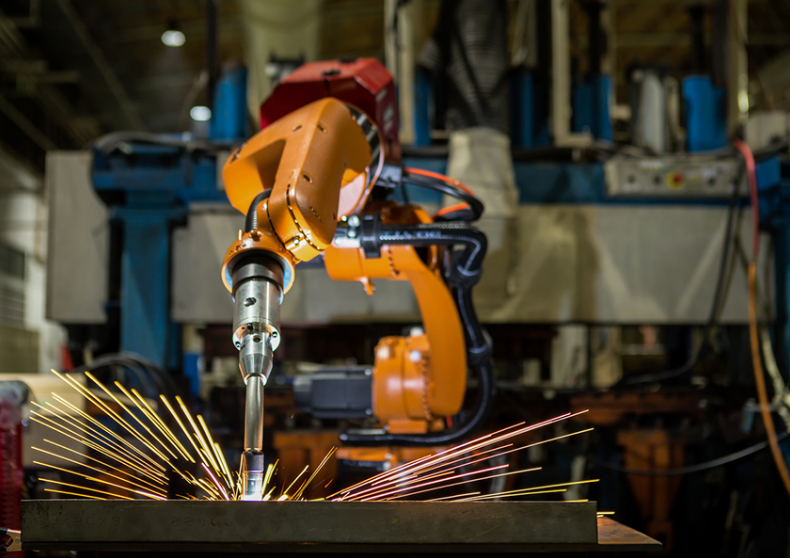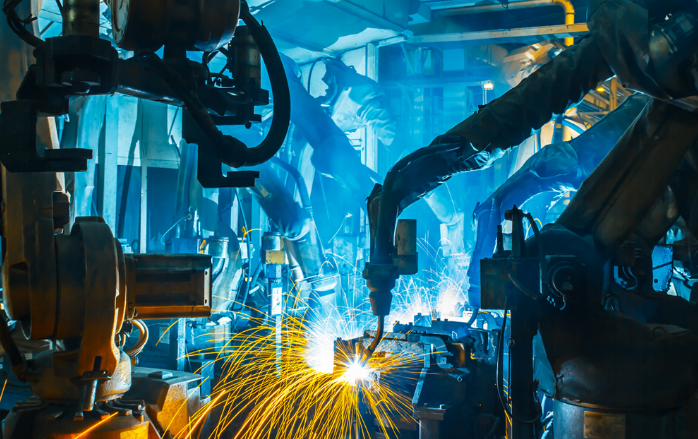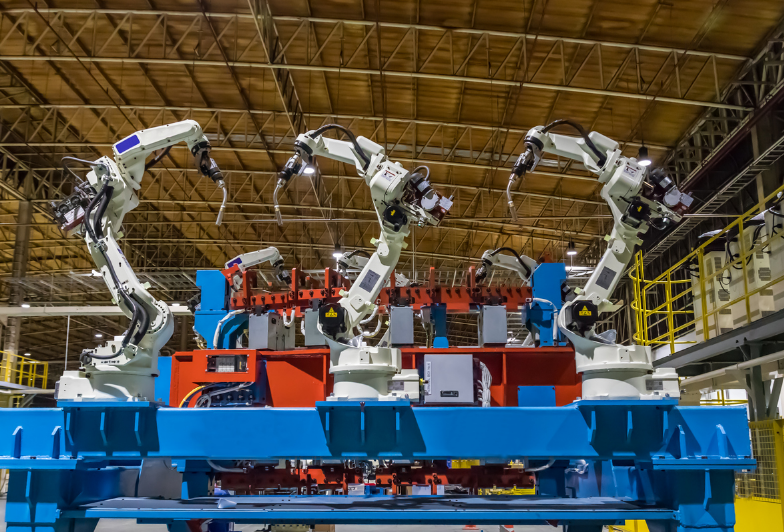Fundamentals of Robotic Welding
Robotic welding involves automated processes that use robot systems for welding. Robots program to execute precise movements, which they repeat with high consistency. They handle complex tasks, from spot welding to continuous arc welding, and are integral in manufacturing lines.
Definition and Key Concepts
Robotic welding defines as the use of automated machinery to perform welding functions. These robots provide enhanced precision, speed, and repeatability. Key concepts include the welding robot, the controller, and the programming software. Understanding these elements helps in optimizing the welding process for different materials and joint types.
History and Evolution
The evolution of robotic welding began in the 1960s with the first industrial robots. Over time, advancements in technology have increased their capabilities dramatically. Early models performed simple tasks, but today’s robots can execute complex welding programs with precision. The history of robotic welding reflects broader industrial trends towards automation and efficiency.

In the context of welding, robots offer a significant increase in efficiency, often completing tasks three times faster than manual laborers. For instance, in automotive assembly lines, robotic welders can consistently operate at speeds that human welders are unable to sustain, significantly reducing the time required for vehicle production.
When discussing costs and budget, robotic welding systems represent a substantial initial investment, often ranging from $50,000 to $200,000. However, they offer long-term savings due to their speed and efficiency, reducing labor costs and minimizing waste.
In terms of specifications and dimensions, welding robots vary widely. Small robots can handle payloads of around 5 kg, with a reach of up to 0.7 meters, while larger models manage over 500 kg and reach up to 3 meters. Each robot is tailored to specific tasks, with the parameters selected based on the requirements of the production line.
Robotic welding systems also have a notable lifespan. With proper maintenance, a robotic welding system can operate for 10 to 15 years. During this time, the precision and quality of welds remain consistently high, with a defect rate significantly lower than manual welding.
Materials play a crucial role in robotic welding, with different robots designed to handle various materials such as steel, aluminum, and composites. The choice of material impacts the welding method and parameters used by the robot.
One of the primary advantages of robotic welding is its superior quality of welds. Robots can maintain a perfect trajectory and speed, resulting in welds that are consistent and of high integrity.
However, the main disadvantage lies in the initial costs and the need for skilled technicians to program and maintain the systems. The cost of a robotic welding system includes not just the robot but also ancillary equipment and software, which can be significant. Nonetheless, the increased productivity and consistent quality often justify the investment.
Types of Robotic Welding
Robotic welding technology has evolved to include several types, each suited for specific industrial applications. They range from handling delicate electronic components to constructing heavy steel frameworks.
Arc Welding Robots
Arc welding robots use electric arcs to fuse metal. They can work with various power supplies, providing flexibility in welding different materials. These robots carry out tasks with precision, achieving consistent welds at a high speed. They suit heavy-duty tasks in environments that challenge human welders.
Resistance Welding Robots
Resistance welding robots apply pressure and pass current through metal pieces to join them. They are ideal for tasks requiring high throughput and are commonly used in the automotive industry for welding sheet metal. These robots offer savings by reducing welding time to mere seconds per joint.
When addressing the speed of robotic welding, it’s notable that arc welding robots can operate at a pace that significantly exceeds manual welding speeds, often doubling or tripling the amount of work a human could accomplish in the same timeframe.
In terms of efficiency, resistance welding robots excel, as they convert up to 90% of the electrical energy into heat, making them energy-efficient options for manufacturers looking to reduce power consumption.
The cost of robotic welding systems can be a factor in their adoption. Arc welding robot setups can start around $30,000 for a basic configuration, while advanced systems with multiple robots and laser-guiding technology can exceed $200,000.
Specifications for robotic welding systems are diverse. For example, the power supply for an arc welding robot can range from 300 to 600 amperes for heavy industrial applications. Resistance welding robots are often rated by the force they apply, which can be anywhere from 5 to 600 kilonewtons.
Material compatibility is key for both types of welding robots. Arc welding robots can handle a variety of metals, including steel, stainless steel, and aluminum, which makes them versatile for multiple industries.
Quality assurance is another significant advantage of using welding robots. They deliver welds with minimal error margins, often below 1%, which is a level of consistency difficult to achieve manually.
A drawback to consider is the upfront cost associated with integrating robotic welding into production lines. Despite this, the return on investment often materializes through improved productivity, lower long-term labor costs, and consistent high-quality output.
Components of Robotic Welding Systems
Robotic welding systems consist of several core components that work in unison to automate welding tasks. These include the robotic arm itself, the manipulators that position the workpieces, and the power sources that drive the welding process.
Welding Robots and Manipulators
Welding robots are the central units in robotic welding systems. They have articulated arms designed for a high degree of movement precision. Manipulators hold and position the pieces to be welded, allowing the robot to perform its task effectively. They can rotate workpieces in multiple axes, accommodating complex welding tasks.
Robots have payload capacities that may range from a few kilograms to over a thousand kilograms, allowing them to handle various sizes and weights of materials. Manipulators must match these capacities and provide stability and precision.

Power Supplies and Controllers
Power supplies for robotic welding systems are critical for their operation. They regulate the current and voltage necessary for the welding process. Controllers act as the brain of the operation, executing programmed welding paths with precision. They ensure that the robot operates within the set parameters to achieve consistent welds.
The power required by welding robots varies, with some systems drawing over 10 kW during operation. This power must be precisely controlled to prevent damage to the materials being welded.
Robotic welding systems offer manufacturers cost savings in the long run. Although the initial setup might cost between $100,000 to $500,000 depending on the complexity, they can operate continuously over long periods with minimal downtime.
These systems can last for over a decade with proper maintenance. Manufacturers consider this lifespan when calculating the return on investment, as the systems often pay for themselves within a few years through increased productivity and reduced waste.
Speed is another advantage, with some robotic welding systems completing welds in a fraction of the time it would take manually. They can significantly increase throughput, essential in high-volume production environments.
Despite the advantages, the cost of maintenance and the need for skilled operators can be a downside. Skilled technicians are necessary to program and maintain these advanced machines, which can add to the operational costs. However, with the advancement in user-friendly interfaces and training programs, this challenge is becoming less significant.
Applications of Robotic Welding
Robotic welding plays a pivotal role in enhancing productivity and quality across various industries. It offers solutions to complex welding challenges and supports high-volume production needs.
Automotive Industry Uses
In the automotive industry, robotic welding is crucial for assembling vehicle chassis and body parts. Robots perform tasks with high precision, maintaining a consistent quality that manual welding cannot match. They weld car components quickly, often completing joints in a few seconds, which significantly speeds up the production line.
The automotive sector often employs spot welding robots because of their efficiency in joining sheet metal. These robots can perform hundreds of welds on a single car body, working tirelessly around the clock. This level of output could cost millions in manual labor, while robots do it at a fraction of the price.

Aerospace and Defense Sector
Robotic welding is also vital in the aerospace and defense sector, where it’s used to construct aircraft and military hardware. The materials used here, such as titanium and aluminum, require precise welding techniques that robots can consistently execute.
The aerospace sector values robotic welding for its ability to maintain high-quality standards, essential for flight safety. Robots can weld complex components like engine parts and fuselage sections, often working with power supplies exceeding 30 kW to ensure deep weld penetration for thick materials.
Weld quality is critical in the aerospace industry, with robots achieving a defect rate less than 1%, which is significantly lower than what manual welding can achieve. This precision is crucial in an industry where every weld could be a matter of life and death.
The cost of implementing robotic welding in aerospace is high due to the need for advanced systems capable of handling specialized materials and complex geometries. However, the investment is justified by the improvements in safety, quality, and speed of production.
Robotic welding systems in aerospace must adhere to strict specifications and parameters, often requiring custom-designed robots and manipulators. This customization can lead to higher costs but results in a system perfectly suited to the specific requirements of aerospace manufacturing.
Despite the high upfront costs, the longevity and efficiency of robotic welding systems contribute to a favorable long-term return on investment. With proper maintenance, these systems can last for many years, far outlasting the initial expense.
Speed is again a notable advantage in the aerospace sector. Robotic welding can reduce production times by a significant margin, allowing for faster turnaround times on aircraft construction and repairs.
One disadvantage in both industries is the inflexibility of robotic systems once programmed for specific tasks. Changing production specifications can require substantial reprogramming and downtime, which can be costly. However, with advancements in adaptive welding technologies, robots are becoming more versatile and able to adjust to new tasks more quickly.
Advantages of Robotic Welding
Robotic welding systems bring a host of benefits to industrial manufacturing processes. They streamline operations, reduce errors, and significantly improve the quality and consistency of welding jobs.
Precision and Consistency
Robotic welding systems offer unparalleled precision. They follow programmed paths with an accuracy measured in fractions of a millimeter, ensuring welds are placed exactly as designed every time. This high level of precision results in consistently strong and reliable welds across every piece produced.
The consistency that robotic welding provides is critical in applications where the slightest variation can lead to product failure. Robots can repeat the same weld cycle continuously without deviation, resulting in a product defect rate that often drops below 1%.
Increased Production and Efficiency
Robotic welding greatly increases production speed. Robots can operate 24/7, with only brief stops for maintenance, significantly outpacing the output of manual welding operations. This continuous operation can often cut production times in half, dramatically increasing overall efficiency.
Efficiency gains from robotic welding also come from minimizing the waste of materials. Robots apply the exact amount of filler material needed for each weld, reducing the excess and rework that can occur with manual welding.
When it comes to costs, robotic welding systems can be expensive to set up, with prices ranging from tens to hundreds of thousands of dollars depending on the complexity. However, the efficiency and speed they bring often lead to cost savings over time, as they reduce the need for skilled welders and can produce more in less time.
The materials used in robotic welding, such as wires and gases, are used more efficiently by robots, which conserves resources and reduces the overall material costs for manufacturing operations.
In terms of quality, robotic welding often produces stronger welds than manual processes, improving the overall quality of the final product. This can be a significant advantage in markets where quality is a key differentiator.
One potential downside is that robotic welding systems require a significant initial investment and ongoing costs for programming and maintenance. However, the improvements in speed, efficiency, and quality often outweigh these costs, resulting in a positive return on investment over the life of the system.




